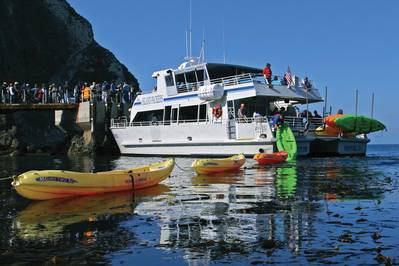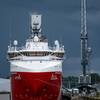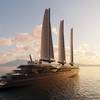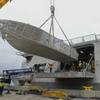Power to the People
Passenger ferry and tour boat market segment has suddenly been revitalized and is on the verge of becoming hot.
It is no secret: new vessel construction for the passenger vessel industry came to a virtual standstill in conjunction with the troubled economy. For many operators, just keeping the shingle hung, skilled crew at hand and something afloat at the other end of the mooring line has required the most scrupulous cost controls and strategy. With the results of the past election now set and several years of waiting and seeing under their belts, passenger vessel operators now need to catch up, make the investment, and move forward with a new craft.
Boat builders are encouraged by current contracts for passenger ferries and tour boats and pending contracts for more of the same. This market segment has suddenly been revitalized and is on the verge of becoming hot. Shipyards like All American Marine, Blount, Gladding-Hearn, Kvichak, Nichols, and Vigor have all recently benefitted from new orders for passenger vessels. The phones are ringing, quotes are being calculated, and pages in the order books are getting filled.
It’s a People Thing
Like any savvy customer, passenger vessel operators are expecting more from their new vessels. Purchasing a multi-mission platform that will attract ridership is the key. Ridership is everything and operators are always looking for ways to maximize passenger capacity. Vessel size plays a large part in capacity constraints, but the USCG also gets their say. By far, the majority of inspected passenger vessels fall into the Subchapter T category which sets a cap at a maximum of 150 passengers on board. The recent change in stability regulations that requires passenger weight calculations to assume 185 pounds (up from 160) per passenger has also had a significant impact on the allowable number of passengers. Beyond this, aging baby boomers and the ADA’s forthcoming vessel design recommendations will require that usable seat space to be reevaluated for greater accessibility. This can mean long ramps, access for scooters, and even elevators. That said; vessels built now, before further enforceable regulations are implemented, can utilize a more practical design for accessibility that won’t significantly sacrifice headcount.
All Aboard?
What do we need to do to get commuters out of their cars and onto a floating transit system? For passenger ferries, success is commonly found when there is no other suitable alternative; otherwise, the motivation has to come from cost savings, time savings, emotion, amenities, or a combination thereof. Factors like rising fuel costs will push people to seek a ticket to ride, but it is more likely to be the little things that will end up tipping the decision scales. For example, the airlines have discovered that something as simple as ambient mood lighting can be quite appealing for passengers. Setting the mood for commuters during the dark hours of early morning or evening can easily be accomplished with color changing and dimmable (energy efficient) single fixture LED’s or LED rope lighting.
In today’s ‘e’-society, connection to the internet and access to a power supply is very high on the list of desirable amenities. Again, the airlines, commuter trains, and even contemporary buses seem to have a good handle on offering both of these features to their customers; yet marine transit seemingly lags far behind. Offering internet at sea will certainly come at a premium, but providing free recharging stations or power outlets can be relatively easy and affordable to install with negligible impact to operating costs.
If possible, rethink the floor plan. For a unique arrangement, get out of the conventional box of long aisle ways with forward facing seats. Angled rows provide a more pleasant viewing opportunity. The view is the primary product offering sold by tour companies and window seats are always the choicest. Owners can get double vision potential by simply elevating the centerline sections of seats a mere 6”. This layout works best when center seats face outboard towards perimeter windows.
New boat buyers like tour operator Harbor Breeze Cruises, are moving full speed ahead with a boatload of passenger-pleasing features including a fully accessible walk-around deck, stadium-tiered foredeck seating, and LED color changing lighting systems throughout the vessel. And, unlike most other staunchly white vessels, Harbor Breeze will really make a splash with a vibrant multi-colored paint scheme.
Free Rides are Never Free
Thanks to MARAD, many public ferry operators can get significant portions of their new vessel paid for by the Ferry Boat Discretionary Program. The program presents several hoops to jump through which does end up overinflating the purchase price. Furthermore, many government funded ferries are constructed under the Field of Dreams philosophy of ‘build it and they will come’. Building the boat is part of it, but schedule, ticket price, and the customer’s perceived value are the other must haves for a successful passenger vessel operation. While agencies like MARAD can help operators procure a new boat, they do not have means to supplement operating capital, which can quickly leave a vessel high and dry. The misfortunes of the Spirit of Ontario, Hawaii Superferry and M/V Susitna have proven to be very expensive lessons to learn.
Keeping Watch
While the future is looking quite bright for the passenger vessel industry, challenging obstacles remain to be navigated. Groups like the Passenger Vessel Association (PVA) provide a wealth of educational resources and advocacy to help their members maintain successful and safe operations. PVA will be hosting their annual national convention, Maritrends, in Jacksonville, FL in February. Topics addressed at Maritrends and of general interest to passenger vessels operators in the year ahead concern ADA vessel design standards, re-interpreting the Guide to Structural Fire Protection (NVIC 9-97 change # 1), and what to expect during the transition from EPA Tier II to Tier III engines.
(As published in the January 2013 edition of Marine News - www.marinelink.com)











